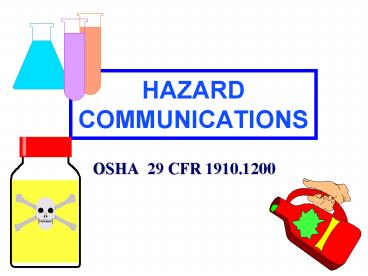HAZARD COMMUNICATIONS PowerPoint PPT Presentation
1 / 17
Title: HAZARD COMMUNICATIONS
1
HAZARD COMMUNICATIONS
- OSHA 29 CFR 1910.1200
2
Requirements of theStandard
- MSDS Labeling
- Written
- Program
- Inventory Training
3
HOW TO CONDUCT A WORKPLACE INVENTORY
- Identify Materials By Department.
- Note Operations Performed Dept. By Dept.
- Look at Labeling.
- Identify Material by Processes.
- Look at materials use by other Contractors.
- Look at materials on site and in storage.
- Look in all areas.
4
HAZARDOUS MATERIAL INVENTORY
5
Material Safety Data Sheets (MSDS)
- Purpose
- What Information they provide
- Readily accessible/complete/retain
- Someone responsible
6
Labeling
- Purpose
- What information is required
- Accessible/Legible/in English
- Types Mfg.s, HMIS, NFPA
- Someone responsible
Zip Cleaner
7
Manufacturers Label
- Mfg.s Name/Address
- Product Name
- Physical Warnings
- Health Hazard Warnings
- Including Target Organs
Zip Cleaner XYZ Company PO Box 1 Anytown,
OH Flammable, Avoid Prolong Breathing
8
In House Label
- Product Name
- Physical Hazards
- Health Hazard Warnings
- Including Target Organs
Zip Cleaner Flammable, Avoid prolonged breathing.
9
Chemical Name
Health Hazard
Fire Hazard
Flash Points 4-Below 73 F 3-Below 100 F 2-Below
200 F 1-Above 200 F 0-Will not burn
4-Deadly 3-Extremely Hazardous 2-Hazardous 1-Sligh
tly Hazardous 0-Normal material
(red)
(blue)
Specific Hazard
Reactivity
4-May detonate 3-Shock and heat may
detonate 2-Violent chemical change 1-Unstable if
heated 0-Stable
Oxidizer OX Use NO WATER W
(yellow)
(white)
NFPA Label
10
HMIS LABEL
(blue)
Health
Flammability
(red)
(yellow)
Reactivity
(white)
Personal Protective Equipment
Chemical Name______________________________
11
Employee Training
- General Training
- Specific Training
12
General Training
- Hazard Communication Standard
- Employers Written Program
- Location/Availability Of Written Program MSDS
- How to read labels MSDSs
13
Specific Training
- Characteristics
- Health Safety Hazards
- Work practices or SOPs
- Emergency action plans
- Personal Protective Equipment (PPE)
- Non-routine tasks
- Industrial Hygiene monitoring results
14
Written Program
- Must be developed, implemented maintained
- A blueprint for how the requirements will be met
- Readily accessible
HazComm Program
15
Miscellaneous
- Non-Routine Tasks
- Piping Systems
- Contractors/
- Multi-Employer Worksites
16
Summary
- What is Hazcom?
- Why was the Hazcom Standard implemented?
- What are the 4 major elements of our written
Hazcom program? - Why is a workplace inventory important?
- What is the purpose of an MSDS?
17
Summary (continued)
- Where do we keep MSDSs Written Program?
- Who is responsible for maintaining MSDS in your
area? - What labeling system do we use?
- Why do we need MSDS and labeling?
- Why do we train on Hazcom?
- Whats the difference between General and
Specific training?

